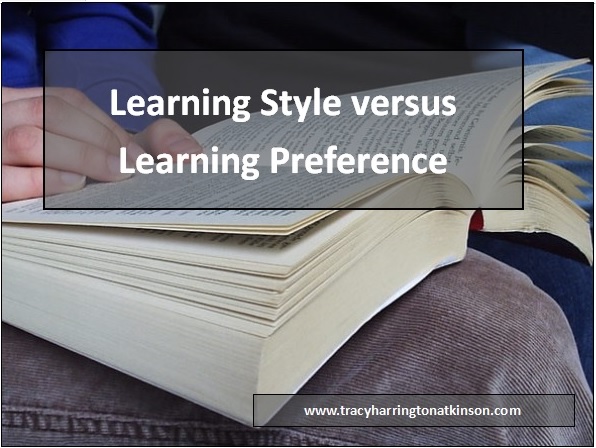 Learning Style Versus Learning Preference
Learning Style Versus Learning Preference
Individuals learn in daily circumstances, whether on their job, in school (or formal educational setting) and even sitting in front of a television or video game. Despite these various options, some learning experiences certainly have greater value and provide conditions indicative of deep learning for individuals. These conditions are called a preferred learning style.
Margaret Anderson (2016) defines a learning styles as “the overall patterns that provide direction to learning and teaching. Learning style can also be described as a set of factors, behaviors, and attitudes that facilitate learning for an individual in a given situation” (para. 5). In contrast, a learning preference is the the set of conditions related to learning which are most conducive to retaining information for an individual. These conditions may include environmental, emotional, psychological, physical and even social attributes (Pritchard, 2009).
Learning Style

For other learning styles: MBTI Learning Styles – A Practical Approach Available in paperback; Kindle; and pdf versions
Learning style or a “preferred intellectual approach to learning” (ibid., 2009, p. 43) is the method by which new information is introduced. An example will best differentiate between these two terms. My husband and I decided to put in raised garden beds one year. I quickly had an idea in my head of what I wanted to do and how to do it. I searched out information, found what I needed and knew I wanted to build my beds inexpensively out of abandoned pallets. I animatedly explained what I wanted to do and how to do it. My husband was lost. He could not understand what I was saying.
For me, information is easily acquired verbally while he leans toward visual and audio. He prefers to have the visual with the audio. To solve the dilemma, I quickly sketched out my idea on a napkin which was received with just as much enthusiasm as he captured my vision. That weekend, our family picked up pallets, cut them and installed them.
Other learning styles may include touch. Experimentation. Or maybe you like to listen and read to a book at the same time. Movement can be associated with learning. The important piece to recall is that none of these styles is better than or more valuable than another.
Learning Preferences
In contrast to our learning styles is our learning preferences. My husband and I both pursued degrees within higher education simultaneously. He preferred to sit at the kitchen table, sprawl out his materials and have background noise –generally a headline news show which would cycle through every 30 minutes or so. In contrast, my study was secluded. My desk was set up in the office where it was quiet and in front of a window with lots of natural light. Even the ticking of a clock could be a hindrance to my learning, depending on the depth of the material.
Other examples of learning preferences may include where one studies. Does the student prefer to sit in a chair or spread across the floor? Is food or drink involved? Is there a special writing utensil? Is there a time of day which is better for learning? Does the individual prefer to learn prior to eating or just following? A learning preference can consist of any of the conditions and all of them. These variables are as diverse as there are people on the earth. The key is to discover the best circumstances for learning for each person and to recognize that no style is better than another (Weimer, 2008).
These learning styles and preferences are not set. They are not fixed traits which will not be altered during life. As a teenager, I listened to music (at a high volume when I could get away with it) and did my work. It made it easier for me to retain information. As I aged, my choices changed. I preferred quiet. I also realized that I learned faster and retained information with greater ease when I highlighted, underlined, wrote and even doodled in my books, notebooks and learning journals. I could easily recapture the knowledge as needed.
Knowing one’s learning styles and learning preferences is key to opening the door to a life of learning. As individuals learn and understand their learning selves, they will have a greater desire to acquire more knowledge. They will be actively involved in the learning process (Weimer, 2002). There will be greater success in learning. Self-esteem improves. Motivation increases. Autonomy and a sense of control are derived (Williams & Williams, 2016).
Sources:
Pritchard, A. (2009). Ways of learning: Learning theories and learning styles in the classroom (2nd ed.). New York, NY:Routledge.
Weimer, M. (2002). Learner centered teaching: five key changes to practice. San Francisco, California: Jossey Bass.
Weimer, M. (2008). Is There a Connection Between Learning Styles and Preferences? Retreived from http://www.facultyfocus.com/articles/is-there-a-connection-between-learning-styles-and-preferences/
Williams, K. & Williams, C. (2016). Five key ingredients for improving student motivation. Research in Higher Education Journal. Retrieved from http://www.aabri.com/manuscripts/11834.pdf
Tracy Harrington-Atkinson, mother of six, lives in the Midwest with her husband. She is a teacher, having taught elementary school to higher education, holding degrees in elementary education, a master’s in higher education and continued on to a PhD in curriculum design. She has published several titles, including Calais: The Annals of the Hidden, Lemosa: The Annals of the Hidden, Book Two, Rachel’s 8 and Securing Your Tent. She is currently working on a non-fiction text exploring the attributes of self-directed learners: The Five Characteristics of Self-directed Learners.


Comments are closed